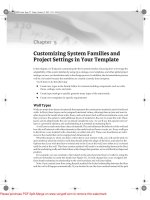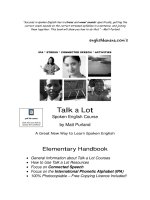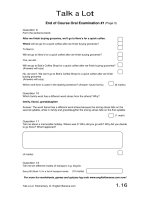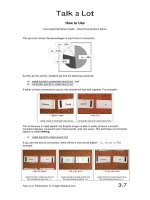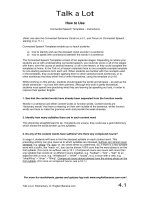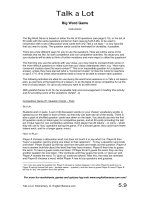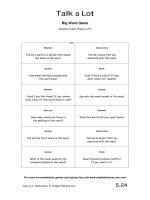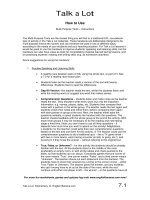Tài liệu Spoken english elementary handbook part 6 doc
Bạn đang xem bản rút gọn của tài liệu. Xem và tải ngay bản đầy đủ của tài liệu tại đây (181.02 KB, 15 trang )
Talk a Lot
How to Use
Connected Speech Templates – Instructions
For more fun worksheets, games and quizzes log onto www.englishbanana.com now!
Talk a Lot Elementary © English Banana.com
4.1
(Note: see also the Connected Sentence Cards on p.3.1, and Focus on Connected Speech
starting on p.11.1.)
Connected Speech Templates enable you to teach students:
a) how to identify and use the stressed vowel sounds in a sentence
b) how to speak with connections between the words in a sentence
The Connected Speech Templates consist of ten separate stages. Depending on where your
students are at with understanding connected speech, you could do some or all of the stages
with them, over the course of several lessons, or all in one lesson; or they could complete the
templates at home. In the Talk a Lot lesson materials there is one complete example template
for one starting sentence from each unit. When students are familiar with the concepts used
in the templates, they could begin applying them to other sentence block sentences, or to
other sentences that they either find or write themselves, using the template on p.4.6.
Whilst working on this activity, students should speak the words and phrases – as well as the
whole sentences – out loud with their partners. Although this work is partly theoretical,
students must spend time practising what they are learning by speaking out loud, in order to
improve their spoken English.
1. See that the content words have already been separated from the function words
Words in a sentence are either content words or function words. Content words are
“dictionary words” that have a meaning on their own outside of the sentence, whilst function
words are there to make the grammar work and provide the weak stresses.
2. Identify how many syllables there are in each content word
This should be straightforward to do. If students are unsure, they could use a good dictionary
which shows the words broken up into syllables.
3. Do any of the content words have suffixes? Are there any compound nouns?
In stage 4, students will have to find the stressed syllable on each content word. This
preceding activity can give clues as to which syllables are stressed. Suffixes are almost never
stressed
, e.g. shopp -ing, doct -or, etc (word stress is underlined). So, if there is a two-syllable
word with a suffix, like “teach -er”, you can be almost 100% sure that the word stress is on the
first syllable. (For more on suffixes, see p.15.1.) Compound nouns are nouns with more than
one syllable that consist of: a) different nouns together, e.g. “football” = “foot” + “ball”; b) an
adjective with a noun, e.g. “whiteboard” = “white” + “board”, or c) a noun with a verb, e.g.
“shoplifting” = “shop” + “lifting”. Compound nouns almost always have the strong stress on the
first syllable. (For more on compound nouns, see p.16.1.)
Talk a Lot
How to Use
Connected Speech Templates – Instructions
For more fun worksheets, games and quizzes log onto www.englishbanana.com now!
Talk a Lot Elementary © English Banana.com
4.2
4. Mark the stressed syllable on each content word
“How do I know which syllable in a word is stressed?”
Each content word has one strong stress, which is always on a vowel sound. There is usually
one vowel sound in every syllable. Content words with only one syllable carry the stress on
the whole word. The majority of words in a sentence or text will fall into one of three groups:
i) one-syllable words – the stress falls on this syllable
ii) words with suffixes – for two syllable words the stress falls on the first syllable; for
longer words, we know that the suffix is almost always unstressed
iii) compound nouns – the stress almost always falls on the first syllable
This gives us lots of help in finding the stressed syllables in a sentence. See p.13.1 for a more
detailed guide to identifying word stress.
More tips:
a) Look in your dictionary for the phonetic spelling of the word and you will see the
strong stress mark like this
LDL
before the stressed syllable. If your dictionary doesn’t
have each word spelled in the International Phonetic Alphabet (IPA), try to get one
that does.
b) When you learn new words, don’t just learn the spelling, but also learn which syllable
has the strong stress and how the word sounds. If you don’t already know the
phonetic alphabet, start learning it today, using the materials in this handbook (see
p.18.1). It should be an essential part of learning spoken English, rather than an
optional extra.
5. Identify the vowel sound of each stressed syllable
Students should use the phonetic alphabet chart on p.18.6 to help them with this stage. When
they have done this they will have the “sound spine” of the whole sentence. These vowel
sounds are the most important sounds in the sentence. If students can get these vowel
sounds right, with the right rhythm, they will have an excellent chance of being understood,
even if they mispronounce a few consonant sounds, or miss out some function words. Let’s
illustrate this with an example. Take the following dialogue (stressed syllables are underlined):
Mel: What
are you doing at the weekend?
Jim: I’m help
ing a friend move house.
On the printed page it’s easy to understand, but let’s imagine that the conversation was taking
place during breakfast and that Jim answered with a mouthful of toast (stressed syllables are
underlined):
Jim: A mel
pina fre moo vow. L]DãÉïKéfå=]DÑêÉ\=DãìW=Dî~rL
(IPA – stressed vowel sounds are bold)
There are some consonant sounds missing, in particular the beginnings of words (“helping”
and “house”) and the ends of words (e.g. “friend” and “house”), all examples of elision. There
Talk a Lot
How to Use
Connected Speech Templates Instructions
For more fun worksheets, games and quizzes log onto www.englishbanana.com now!
Talk a Lot Elementary â English Banana.com
4.3
is a LùL sound instead of the LọL in helping, an example of assimilation. There is a glottal stop
L\L to replace the nd of friend. Words have been linked together (Im helping, helping a,
and move house). Its not a good example of Standard Pronunciation, but is it enough to
communicate? I think yes. Try saying it yourself as if you have a mouthful of toast. (Or even
make some toast and then try it for real!) If students can make the correct vowel sounds on
the correct stressed syllables in the sentence and can use the context for guidance about
meaning, in this case, the question What are you doing at the weekend? it should be
possible for them to be understood. Its one of the reasons why people in the UK with wildly
different accents are able to understand each other. There may be some dropped or muffled
consonant sounds, but as long as the right vowel sounds are on the right stressed
syllables its OK. We can further underline the great importance of vowel sounds when we
compare them with consonant sounds. Lets use the same sentence as our example, but
invert the roles, with all the consonant sounds correct, and even the stressed syllables
correct, but the wrong vowel sounds:
Mel: What
are you doing at the weekend?
Jim: Im hall
ping a frond mive horse. L~fó=DĩlWọKộfẽ=]=Dẹờồầ=Dó~fợ=DĩlWởL=
(stressed syllables are underlined) (IPA stressed vowel sounds are bold)
Youre what? Youre hallping a frond? What? Without the correct vowel sounds
communication is severely damaged. So, for good communication, say the correct vowel
sound on each correct stressed syllable.
6. Identify weak forms among the function words
Now lets turn our attention to the function words. Are there any weak forms among them?
See p.17.1 for more information and a useful list of weak forms in English. Here is a summary
of word types that have weak forms:
Word Type:
Examples:
conjunctions: and, but, than, that
prepositions: at, to, for, of, from
verb be: are, am, is
auxiliary verbs: has, have, can, do, were, would
pronouns: he, you, his, her, him, them, your
articles: the, an, a
Because function words are not stressed, we can use their weak forms, e.g.
Lẹ]L
instead of
LẹlWL
,
=
=with the aim of reducing the words that fall between the content words. We cant omit
these words altogether that would make our sentences grammatically incorrect but we
can reduce them, squash them, and make them shorter, thus further emphasising the content
words, and, in particular, the stressed vowel sound in each content word. You might want to
look at function words as being the enemy of rapid speech. All too often students of English
Talk a Lot
How to Use
Connected Speech Templates – Instructions
For more fun worksheets, games and quizzes log onto www.englishbanana.com now!
Talk a Lot Elementary © English Banana.com
4.4
give words like “and”, “to”, “from”, and “can” a full sound and full stress, which messes up the
sentence stress and rhythm of the sentence, by making it much harder to hear the correct
stressed vowel sounds on the content words. Truly, these pesky function words – to, of, for,
a, etc. – try to get above their station far too often and must be SQUASHED!
So, coming back to the connected speech templates… students should look at each function
word and decide whether or not it has a weak form that can be used in the sentence. If it
does, students should write “W” over the greyed out “W” on the template.
7. What kind of sounds connect the words in the sentence?
Next, we come to look at the sounds that connect the words together. For this stage students
will need to know about vowel sounds and consonant sounds. See p.18.6 for a list of all the
sounds in the English language – both vowel and consonant. The connecting sound between
two words will be one of these kinds:
a) consonant sound to consonant sound (cc)
b) consonant sound to vowel sound (cv)
c) vowel sound to consonant sound (vc)
d) vowel sound to vowel sound (vv)
Try saying the words out loud and listen for the sound at the end of the first word and the
sound at the beginning of the second word. Let’s take the words “fifty five” for example. The
sound at the end of the first word (“fifty”) is a vowel sound:
LáL
, and the sound at the
beginning of the second word (“five”) is a consonant sound:
LÑL
, so students would write “vc”
in the box between these two words to denote “vowel sound to consonant sound”. Students
should look for the connecting sounds between the words and write one of the four labels
(above) in each box.
8. Identify techniques of connected speech for each transition between two words
If we know what kind of sounds connect two words, we can have a go at saying which
technique of connected speech will be used. See p.11.3 for more on the techniques of
connected speech. In general, we can say that:
a) if the transition sounds are consonant to consonant (cc), the techniques of connected
speech are likely to be assimilation (A), elision (E), or glottal stops (G). This is
because the English tongue can’t cope with two consonant sounds rubbing together,
so we either get rid of, or change the sound of, one of them.
b) if the transition sounds are consonant to vowel (cv) or vowel to consonant (vc), the
techniques of connected speech are likely to be linking (L), or R-linking (R). This is
because the English tongue is able to easily produce a smooth transition between
consonant and vowel sounds, and vice versa.
c) if the transition sounds are vowel to vowel (vv), the technique of connected speech is
likely to be intrusion (I). This is because the English tongue can’t cope with two
vowels flowing together, so we have to produce a consonant sound –
LàL, LïL,
=or
Talk a Lot
How to Use
Connected Speech Templates – Instructions
For more fun worksheets, games and quizzes log onto www.englishbanana.com now!
Talk a Lot Elementary © English Banana.com
4.5
LêL
– to make the two sounds run together. The aim of connected speech is effective
communication through words that flow together fluently, with a minimum of jarring
sounds.
9. Identify the missing or new sounds between two words
If students find any examples of assimilation, elision, or intrusion – i.e. a sound has changed
(A), is missing (E), or has been added (I) – they should write down the missing or changed
sound(s). This helps to draw their attention to these particular techniques of connected
speech.
10. Write examples using the IPA to show transitions between words
Students should have been saying the sentence out loud, as well as the sound transitions
between the words, throughout the whole of this activity. Finally, they should try to write a few
examples of some of these sound transitions using the IPA. They could use the example(s)
on the answer page for guidance, then use the IPA to write their own examples. Higher level
students could write the whole sentence using the IPA, and annotate instances of connected
speech techniques.
Talk a Lot
Topic: __________________
Starting Sentence: ________________________________________________________________
cc consonant sound to consonant sound
GLACIER:
Contraction a word is shortened
cv consonant sound to vowel sound Glottal stops
an empty space without sound
L\L
Intrusion
a new sound appears –
LàL
,
LïL
, or
LêL
=
vc vowel sound to consonant sound Linking syllables connect together Elision a sound disappears
vv vowel sound to vowel sound
Assimilation a sound changes R-linking
syllables connect with
LêL
sound
Talk a Lot Elementary © English Banana.com
4.6
5
vowel sound:
4
stressed syllable:
1
content word:
2
no. of syllables:
1
function word:
7
connecting sounds:
6
weak forms:
W W W W W W W W
8
features of C.S.:
9
missing/new sound:
10
example(s) with IPA:
____________________________________________________________________________________________________________
3
suffixes:
____________________________________________________________________________________________________________
3
compound nouns:
____________________________________________________________________________________________________________
7 connecting sounds: 8 features of connected speech:
